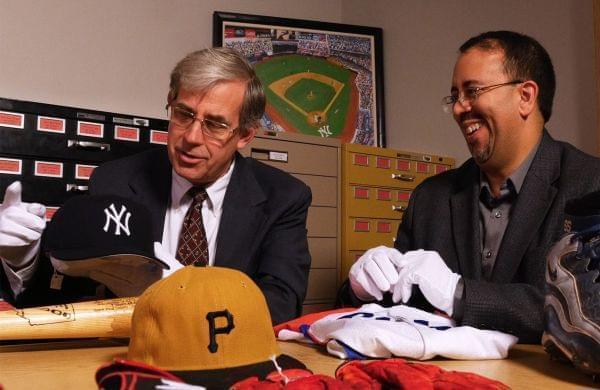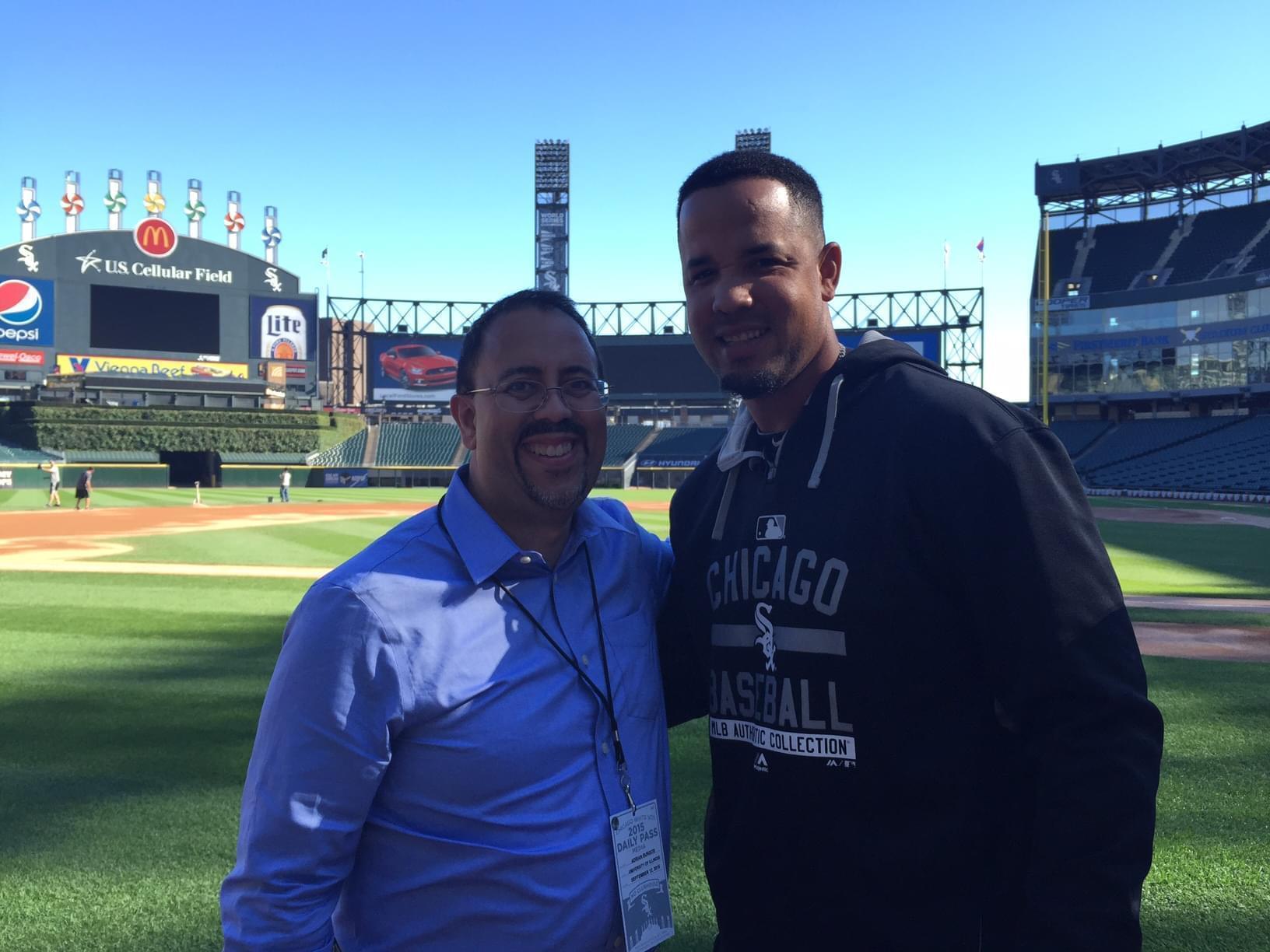Documentary Profiles Latinos’ Role In Shaping Baseball History

U of I History Professor Adrian Burgos with National Baseball Hall of Fame Curator John Odell Kaitlin Southworth, Producer, Big Ten Network
University of Illinois History Professor Adrian Burgos says baseball became a true passion early in life. Through his family and love of the game, learned about the role Latinos have played since the sport’s inception. A new documentary premiering Saturday on the Big Ten Network, "Playing America's Game," traces Burgos' research, and the issues faced by today's Latin players.
A native of New York, Burgos was born just blocks from Yankee Stadium. Even after the family moved to Fort Lauderdale, he kept up with the team, spending time at Little Yankee Stadium, the team's former spring training home.
"Some of my most treasured memories of my youth was my mom dropping me off at spring training practice, even before the games got started," he said. "I would stay there for hours, and I watched Dave Winfield in right field, and watched the Yankees taking batting practice, and (pitchers) Ron Guidry and Goose Gossage. For me, it's kind of like being in baseball nirvana."
A lot of Burgos' love for the game came from his grandmothers, who watched Yankee TV broadcasts with him.
After completing college, he lived for a year with his maternal grandmother, who Burgos says chose to not only root for both the Yankees and New York Mets, but also the team with the most Latino players. Burgos' history lessons in baseball started with looking at the back of baseball cards, learning about the Latin players who came from places like The Dominican Republic and Puerto Rico, including pitcher John Candelaria.
"He was, in fact, a Puerto Rican from New York City," he said. "I was like 'wow, he's Puerto Rican like me.' It made me even more aware of baseball spread throughout the Caribbean world and Latin America, and Puerto Ricans from the island to U.S. communities. This was part of the story that my family had participated, and many of these players had participated in as well."
Burgos' research eventually brought him to the University of Illinois.
“The University of Illinois provided me the perfect setting for me to begin my career,” Burgos explained in the documentary. “They understood that it was more than baseball history. It’s about American immigration stories.”
His research also led to ties with a childhood hero. Winfield, the Yankees Hall of Famer and a later a member of the front office with the San Diego Padres, sought out Burgos' help when putting together a tribute on baseball's Negro Leagues. He wanted to know more about Latin players' participation in those games.
"He’s taught me a lot," Winfield said in the documentary. "I learned a great deal. He was a fantastic advocate for the guys. He understands his history. He’s met many of these people. He knows them intimately. I appreciated his input.”
After the two met, Winfield asked Burgos to sign a copy of his book. Burgos says the two work together often - most recently, just before a group of major leaguers went on their recent tour of Cuba.
In his studies on Latin players, the professor says there was a time around 1915 when very light-skinned Cubans and those with money were making the major leagues based on their talent.
"...But also because they're deemed 'not black," said Burgos. "So they were presented to the public as white Cubans." In the 1930's and 40's, Burgos says there were medium colored baseball players from the Dominican Republic and Puerto Rico who knew to have African ancestry, but again, were presented to the public as 'not black."
Burgos has also had a long-lasting relationship with the Baseball Hall of Fame in Coopertown, N.Y., where he visited numerous times as a graduate student, and has shared his writings of Latino players participating in the Negro Leagues.
"In many instances, we know much more about the lighter skinned Latinos who played in the major leagues, from 1902 to 1947, when Jackie Robinson broke in, numbered about 55," he said. "We know a lot less about the 240 players who participated in the black baseball circuit in the United States. The reality was, the greatest Latino players during that era were playing in the Negro Leagues."
Burgos' research played a role in the "Viva Baseball" exhibit at the Hall of Fame. His book notes that baseball arrived in Cuba at the same time it was establishing its foothold in California - the 1860's. In one of his two books, "Playing America's Game: Baseball, Latinos, and the Color Line," he says Latinos mark the first group of immigrants, particularly out of the Carribbean, to arrive in the U.S. with baseball already being part of their culture.
In the documentary screening Saturday, Burgos spends time with modern day Latino players, including those with the minor league Kane County Cougars in Geneva, Illinois, and White Sox slugger Jose Abreu, a native of Cuba, in a visit to U.S. Cellular Field.

Burgos with Chicago White Sox player Jose Abreu
"I was able to interview them in their native tongue," he said. "So they were speaking in Spanish, feeling comfortable, and sharing." He says Abreu prolonged his interview, talked about his home, and his mother, and how important she was in inspiring him to pursue his major league dreams."
A White Sox legend played a role in Abreu's dreams.
"Minnie (Minoso) such an important role in helping in him grow accustomed to life in the United States, to know that it's possible," Burgos said. "In talking with Jose and others, Minoso remains this huge figure in Cuba. He's a star. He is a Hall of Famer to them. And he's also a pioneer. And they don't lose sight of that."
"Playing America's Game" premieres Saturday night at 6 p.m. on the Big Ten Network, or at the conclusion of the Illinois-Michigan baseball game.
Links
- Syrian Refugees; Voter Registration; Overtime Pay; Latinos in Baseball
- UI Prof: “42” Brings Accurate Story of Racist Abuse Within Baseball
- Stars Come Out For Baseball History Panel At Wrigley Field
- The 21st: Film, Baseball, Books - How Art Affects Life
- Integrated Baseball, A Decade Before Jackie Robinson
- White Sox Legend Minoso Dead At 90
- The Good, the Bad, & the Ugly: Chicago White Sox
- Chicago White Sox Great Minoso Honored at U of I
- Article on documentary from University of Illinois News Bureau
- Viva Baseball exhibit at the National Baseball Hall of Fame
- You Tube link to "Playing America's Game"
